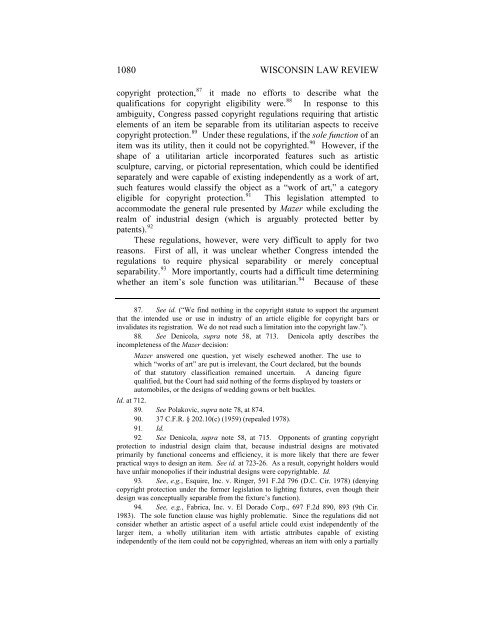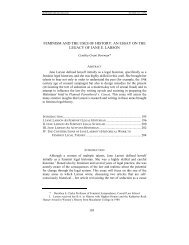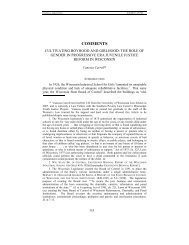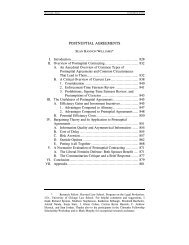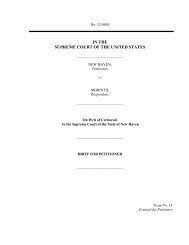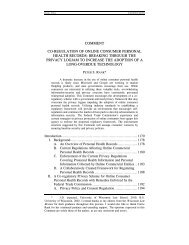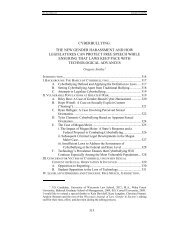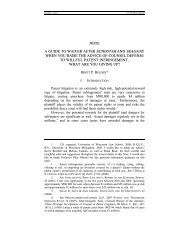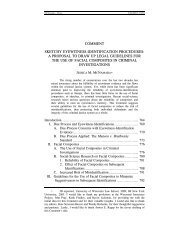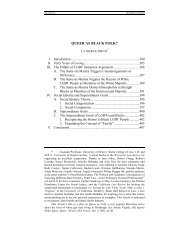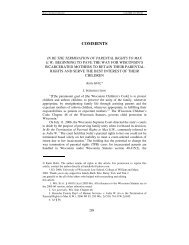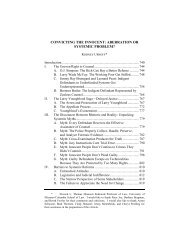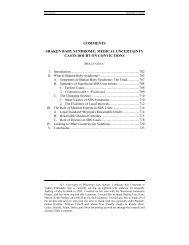Stealing Beauty: Pivot Point International v ... - UW Law School
Stealing Beauty: Pivot Point International v ... - UW Law School
Stealing Beauty: Pivot Point International v ... - UW Law School
You also want an ePaper? Increase the reach of your titles
YUMPU automatically turns print PDFs into web optimized ePapers that Google loves.
1080 WISCONSIN LAW REVIEW<br />
copyright protection, 87 it made no efforts to describe what the<br />
qualifications for copyright eligibility were. 88 In response to this<br />
ambiguity, Congress passed copyright regulations requiring that artistic<br />
elements of an item be separable from its utilitarian aspects to receive<br />
copyright protection. 89 Under these regulations, if the sole function of an<br />
item was its utility, then it could not be copyrighted. 90 However, if the<br />
shape of a utilitarian article incorporated features such as artistic<br />
sculpture, carving, or pictorial representation, which could be identified<br />
separately and were capable of existing independently as a work of art,<br />
such features would classify the object as a “work of art,” a category<br />
eligible for copyright protection. 91 This legislation attempted to<br />
accommodate the general rule presented by Mazer while excluding the<br />
realm of industrial design (which is arguably protected better by<br />
patents). 92<br />
These regulations, however, were very difficult to apply for two<br />
reasons. First of all, it was unclear whether Congress intended the<br />
regulations to require physical separability or merely conceptual<br />
separability. 93 More importantly, courts had a difficult time determining<br />
whether an item’s sole function was utilitarian. 94 Because of these<br />
87. See id. (“We find nothing in the copyright statute to support the argument<br />
that the intended use or use in industry of an article eligible for copyright bars or<br />
invalidates its registration. We do not read such a limitation into the copyright law.”).<br />
88. See Denicola, supra note 58, at 713. Denicola aptly describes the<br />
incompleteness of the Mazer decision:<br />
Mazer answered one question, yet wisely eschewed another. The use to<br />
which “works of art” are put is irrelevant, the Court declared, but the bounds<br />
of that statutory classification remained uncertain. A dancing figure<br />
qualified, but the Court had said nothing of the forms displayed by toasters or<br />
automobiles, or the designs of wedding gowns or belt buckles.<br />
Id. at 712.<br />
89. See Polakovic, supra note 78, at 874.<br />
90. 37 C.F.R. § 202.10(c) (1959) (repealed 1978).<br />
91. Id.<br />
92. See Denicola, supra note 58, at 715. Opponents of granting copyright<br />
protection to industrial design claim that, because industrial designs are motivated<br />
primarily by functional concerns and efficiency, it is more likely that there are fewer<br />
practical ways to design an item. See id. at 723-26. As a result, copyright holders would<br />
have unfair monopolies if their industrial designs were copyrightable. Id.<br />
93. See, e.g., Esquire, Inc. v. Ringer, 591 F.2d 796 (D.C. Cir. 1978) (denying<br />
copyright protection under the former legislation to lighting fixtures, even though their<br />
design was conceptually separable from the fixture’s function).<br />
94. See, e.g., Fabrica, Inc. v. El Dorado Corp., 697 F.2d 890, 893 (9th Cir.<br />
1983). The sole function clause was highly problematic. Since the regulations did not<br />
consider whether an artistic aspect of a useful article could exist independently of the<br />
larger item, a wholly utilitarian item with artistic attributes capable of existing<br />
independently of the item could not be copyrighted, whereas an item with only a partially


